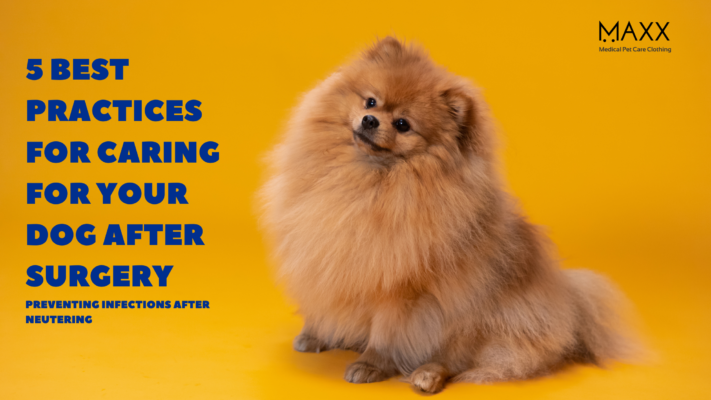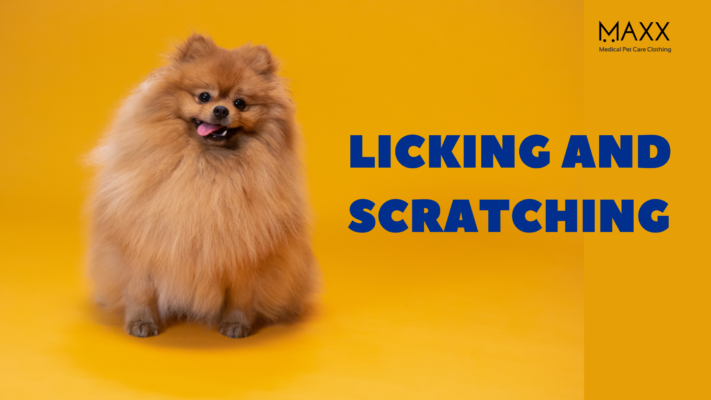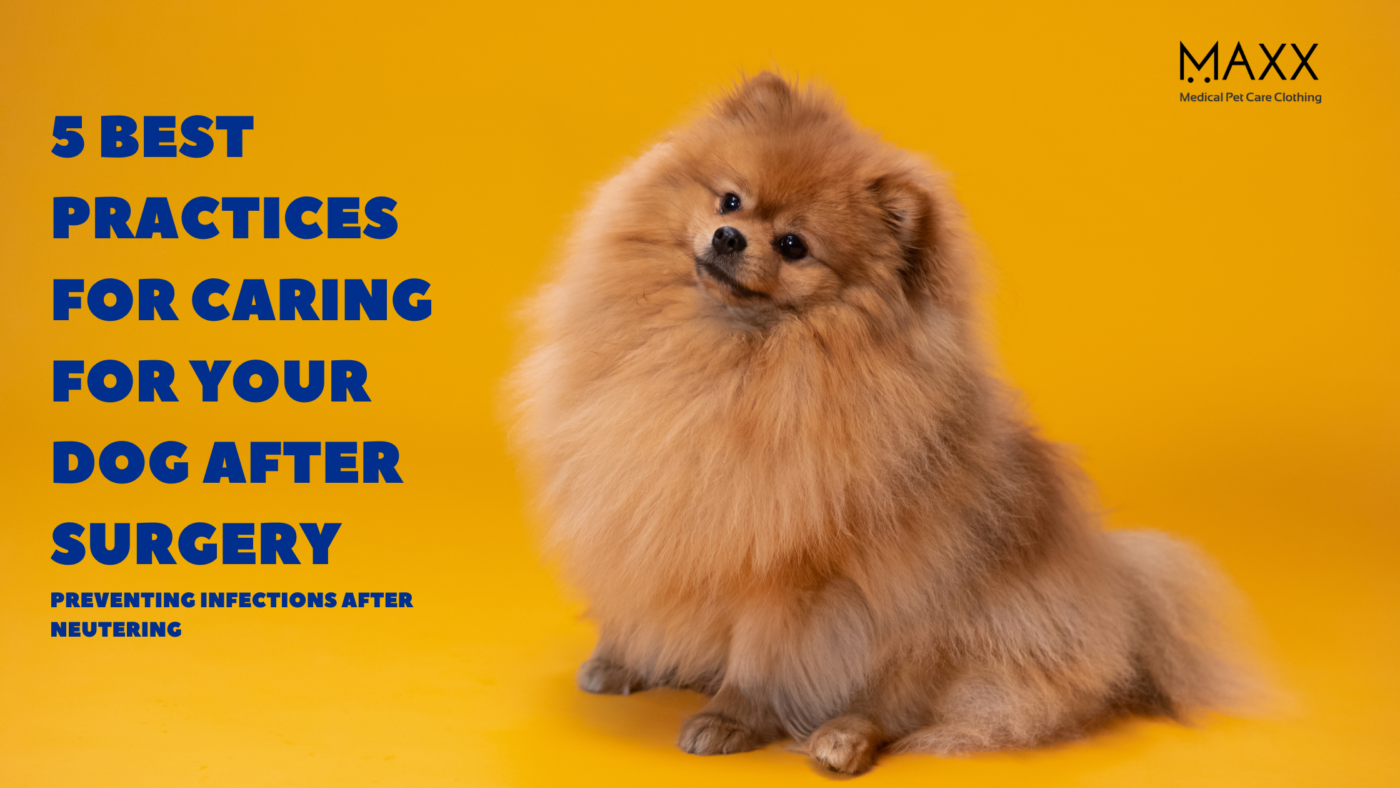MAXX Pet Blogs
5 BEST PRACTICES FOR CARING FOR YOUR DOG AFTER SURGERY

Learn about the best practices for caring for you dog after surgery including using a Recovery Suit from MAXX Medical Care Clothing as an alternative to cones and bandages. Find helpful tips and advice on caring for your dog after surgery to ensure a speedy recovery.
Introduction
- Neutering is a routine surgical procedure for dogs that has many benefits, such as preventing unwanted pregnancies and reducing the risk of certain cancers.
- However, it’s important to take proper care of your dog after surgery to prevent infections and other complications.
- In this article, we’ll discuss the best practices for caring for your dog after surgery and preventing infections.
THE IMPORTANCE OF PREVENTING INFECTIONS AFTER DOG SURGERY
- Infections can occur after any surgical procedure, including neutering.
- Signs of infection include redness, swelling, discharge, and a foul odor. In severe cases, infections can cause fever, lethargy, and even death.
- That’s why it’s crucial to take proper care of your dog after surgery to prevent infections. READ HERE ABOUT “7 Things You Need to Know About What to Expect After Neutering or Spaying Your Dog”
BEST PRACTICES FOR CARING FOR YOUR DOG AFTER SURGERY
- RESTRICT YOUR DOG’S ACTIVITY
- After surgery, your dog needs plenty of rest and should avoid strenuous activities such as running and jumping.
- This will help prevent excessive movement that can cause injury to the incision site and delay the healing process.
- MONITOR THE INCISION SITE
- Check your dog’s incision site daily for any signs of infection.
- If you notice redness, swelling, discharge, or a foul odor, contact your veterinarian immediately.
- KEEP THE INCISION SITE CLEAN AND DRY
- Make sure to keep the incision site clean and dry to prevent infections.
- Avoid bathing your dog for at least ten days after surgery and keep your dog away from water or mud puddles.
- PROVIDE YOUR DOG WITH A COMFORTABLE ENVIRONMENT
- Create a comfortable environment for your dog to rest and recover after surgery.
- Make sure your dog has a soft bed or blanket to lay on and avoid placing your dog in areas with excessive noise or activity.

- USE A RECOVERY SUIT TO PREVENT LICKING AND SCRATCHING
- The original full-body Recovery Suit from MAXX Medical Care Clothing is a professional alternative to a cone and full-body bandage.
- It is suitable for first aid purposes, to protect and cover hot spots, wounds, surgical sutures and bandages, ointments, skin conditions, when in season or incontinence, and more.
- Using a recovery suit can prevent your dog from licking or scratching the incision site, which can lead to infections and other complications. find out more about : Best Post Surgery Bodysuit for Pets in 2023
- CONSULT YOUR VETERINARIAN
- Consult your veterinarian if you have any concerns about your dog’s recovery or if you notice any signs of infection.
- Your veterinarian can recommend appropriate treatment and provide you with further advice on caring for your dog after surgery.
CONCLUSION
Proper care after neutering surgery is crucial to prevent infections and ensure a speedy recovery for your dog.
Restricting your dog’s activity, monitoring the incision site, keeping the incision site clean and dry, providing a comfortable environment, using a recovery suit to prevent licking and scratching, and consulting your veterinarian are all essential steps in caring for your dog after surgery.
By following these best practices, you can help ensure a successful recovery for your furry friend.
FREQUENTLY ASKED QUESTIONS :
Q: How do I stop my dog from scratching at stitches? A:
You can prevent your dog from scratching at stitches by using a recovery suit.
These can help prevent your dog from reaching the stitches with their paws or mouth.
Q: What happens if my dog scratches his stitches?
A: If your dog scratches their stitches, it can cause the wound to reopen, leading to infection or delayed healing.
It’s important to prevent your dog from scratching or chewing at the stitches.
Q: How do I stop my dog from messing with stitches?
A: In addition to using a recovery suit, you can also try distracting your dog with toys or treats to redirect their attention away from the stitches.
If your dog continues to mess with the stitches, consult your veterinarian for additional guidance.
Q: How do you treat a scratch on a dog’s wound?
A: If your dog has a scratch on a wound, clean the wound with mild soap and water, then apply an antibiotic ointment.
You can also cover the wound with a sterile bandage or gauze to protect it from further damage.
Q: Can you put coconut oil on dog stitches?
A: It’s best to avoid using coconut oil on dog stitches, as it can interfere with the healing process and potentially cause infection.
Stick to the treatment plan recommended by your veterinarian.
Q: How long do dog stitches take to heal?
A: The length of time it takes for dog stitches to heal depends on the location and severity of the wound, as well as the type of stitches used.
In general, most dog stitches will take 10-14 days to heal.
However, your veterinarian will be able to give you a more specific timeline for your dog’s recovery.

